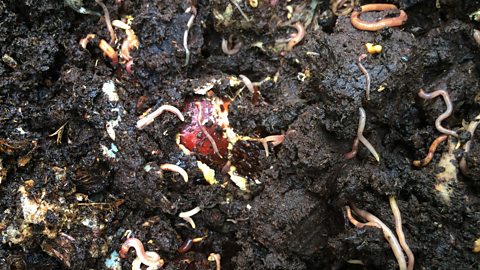Decomposition and the carbon cycle
Nutrient cycles
Within an ecosystemAn area where a community of organisms live and are affected by a range of environmental factors., nutrients begin as simple inorganic Not derived from living matter. compounds (carbon dioxide and nitrate ions), that are taken in by a plant and used to make more complex biological moleculeA collection of two or more atoms held together by chemical bonds..
These molecules are passed along the food chainA sequence (usually shown as a diagram) of feeding relationships between organisms, showing which organisms eat what and the movement of energy through trophic levels..
When plants and animals die, the complex biological molecules are decomposeIf a substance decomposes, it breaks down into simpler compounds or elements..
Decomposition
Dead organisms are broken down into smaller pieces by the process of decay. Organisms such as earthworms are involved in this process.

Decomposition is the process by which bacteria and fungi break dead organisms into their simple compoundA substance formed by the chemical union of two or more elements..
Plants can absorb and use these compounds again, completing the cycle.
Decomposing bacteria and fungi are described as saprophytic because of the way they break down dead organicDerived from living matter. matter.
Saprophytic nutrition involves:
- Bacteria/fungi secrete To release a substance, in this case an enzyme.enzymeProteins that act as biological catalysts, meaning they speed up reactions without being used up themselves. out of their cells into the soil or dead organism.
- The enzymes digest the organic material. This is known as extracellular digestion as it happens outside the cells.
- The products of digestion are absorbed by the bacteria/fungi.
Humus is the organic content of the soil formed from decomposing plants and animals.
Decomposition happens quickly when:
- The temperature is warm
- There is enough moisture
- The decomposing organism has a large surface area
Anaerobic conditions (little/no oxygen available - for example, waterlogged soil) cause the rate of decomposition to decrease.